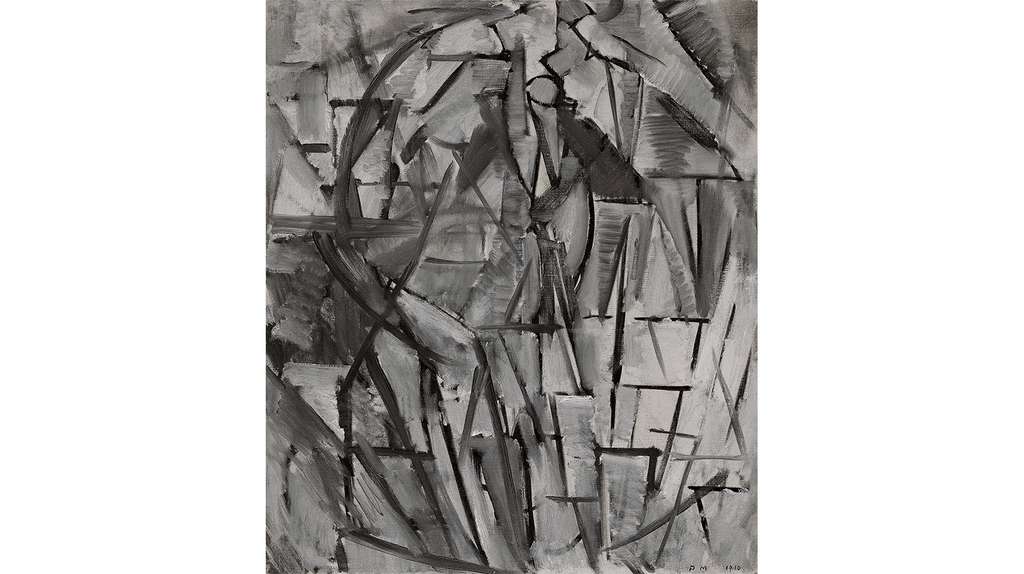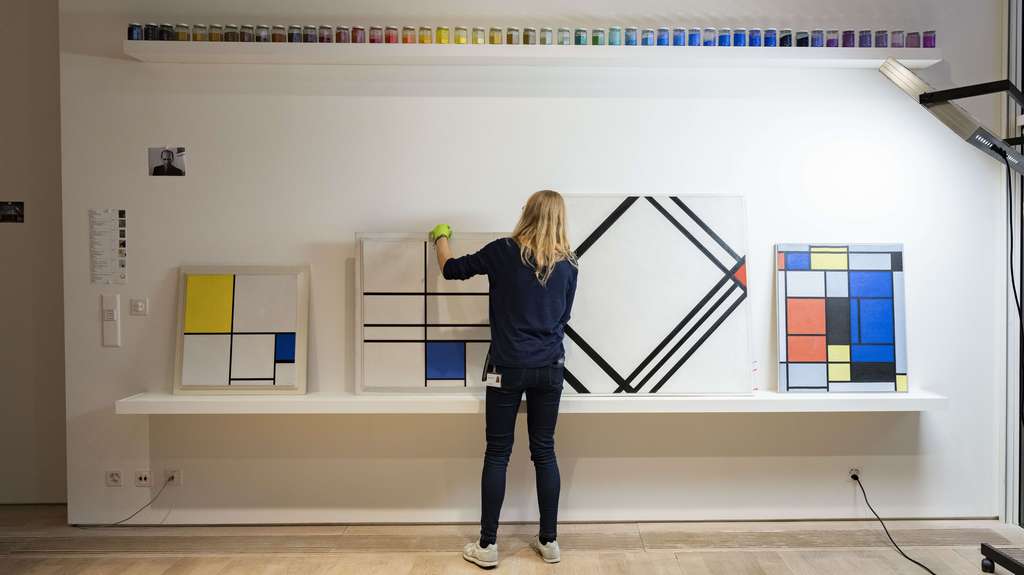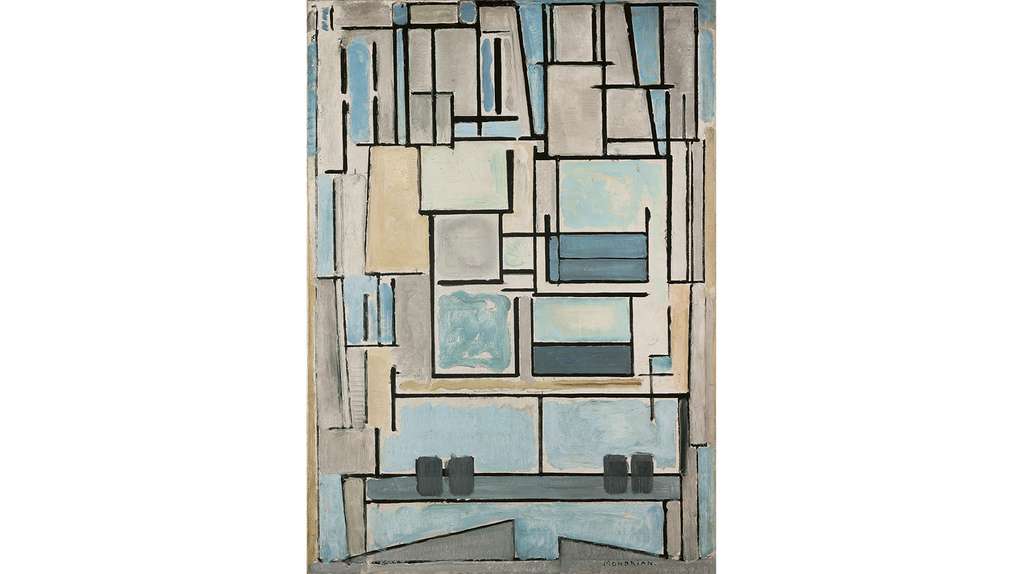Piet Mondrian, Tableau No. I
Piet Mondrian is one of the most important representatives of the artistic avant-garde, when we consider this as a development from figuration to abstraction. He seems to have completed this stylistic evolution within his career, whereby he was always in search of the unity and essence of the image per se. Piet Mondrian found his way to abstraction through his exploration of landscape. Only as from the early 1920s did the artist concentrate on a wholly non-objective pictorial language, which confined itself to arrangements of vertical and horizontal black lines with planes in white and the three primary colors. These are the works that continue to shape the public perception of Mondrian right up to today. Mondrian himself called this style, which he developed around 1920, Neoplasticism.
Tableau I is a key work in this context. Its present-day appearance is the result of a reworking of the painting by Mondrian in 1925. A first version of the work was executed in 1921, and possibly as early as 1920.
Between 1917 and 1920, Mondrian created paintings that are based on a dense and regular grid, and which appear composed as if according to a modular principle. Up to the end of 1920, Mondrian employed thin, gray grid lines; in his subsequent development, these lines then become more dominant, wider, and exclusively black.
The black lines in Tableau I are of uniform breadth, and extend right to the edges of the canvas. In the center of the painting stands a narrow, upright rectangle of black, around which are grouped planes of red, blue and yellow. In the case of the blue, Mondrian has used one dark shade and various pale shades. The yellow and red shades are both relatively light. In terms of palette, Tableau I develops from mixed tones (1920/21) to pure primary colors. It is fascinating to see how Mondrian uses the different color planes to create an optical illusion of space.
The work of our conservators has now shown that Tableau I is likewise based on a regular grid drawn in pencil. Mondrian appears to have oriented himself towards this grid as he developed the linear structure of the picture, and arrived at the geometric structure, with its relative sense of freedom, that characterizes the painting today.
Images of the painting captured with various technical imaging techniques provide important information: visible light, raking light, transmitted light, UV fluorescent light, IR reflected light, IR transmitted light, X-ray.
Third time’s a charm
Clues in the signature
Tableau I bears the double date of 1921 and 1925, written as “21 – 25” next to the signature (the initials “PM”). Mondrian was one of the first artists of his day to give many of his paintings two dates. This brought with it a new conception of the dating of works. Mondrian did not thereby mean to indicate that the picture had taken shape over a prolonged, continuous period. On the contrary, he wanted to emphasize that the painting had been worked on twice, and that there was a gap between these two painting phases, and hence a break in terms of time and style.
Mondrian dated Tableau I for the first time in 1921. Mondrian specialists, however, assign its compositional scheme to 1920 rather than 1921.
Mondrian added the date of 1925 to Tableau I, as well as to three other pictures, after he had reworked these already existing paintings for the exhibition Mondrian, Man Ray, held in September 1925 at Kunsthandlung Kühl und Kühn in Dresden. It has been suggested that, when Mondrian dated Tableau I the second time in 1925, he had either misremembered or simply forgotten the year—1920 or 1921—in which it was originally painted (Mondrian is known for his erroneous “backdatings”).
This suggestion can be refuted, however, by taking a closer look at the signature: Under magnification, it is clearly evident that the number “21” was inscribed into the still fresh, wet paint, and the “25” added much later on top of the paint layer, now long since dry in this area. The work was thus indeed initially dated 1921. Mondrian therefore considered Tableau I to be a finished work once in 1921 and again in 1925.
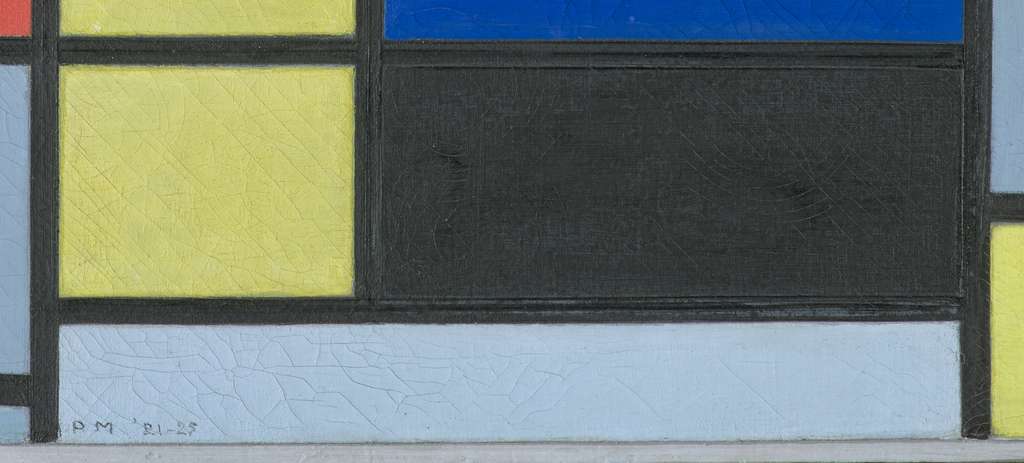
Detail lower edge: signature “PM ’21–25”
Discovery of another date via infrared reflectography
The scientific investigations of Tableau I conducted in the course of the Piet Mondrian Conservation Project were able to reveal—in addition to the double dating described above— the presence of a third, first date. Infrared reflectography is able to make paint layers beneath the present-day surface visible. Depending on the composition of the pigments in these underlying layers, the infrared radiation is absorbed, scattered or transmitted.
The first signature
Lying beneath the signature visible today is an earlier one, of which the lettering “PM ‘2” can be clearly made out. Unfortunately, none of the imaging techniques available to us have been able to reveal the important second digit after the two. This discovery nevertheless provides valuable clues: Tableau I was dated three times and thus considered finished three times by Mondrian. We can therefore identify two possible timelines of working phases: either the artist worked on the painting in 1920, 1921 and 1925, or twice in 1921 and a third time in 1925. The theory, advanced by Mondrian specialists, that Tableau I was painted in as early as 1920, thus cannot be ruled out. Looking more closely at technical details of how the work was painted (see below), the first version could well have been executed in 1920, whereby there is naturally no clear stylistic break between 1920 and 1921 and it is more a question of a flowing work process.
Early exhibitions in 1920 and 1921?
Clues to whether Tableau I was first dated 1920 or 1921 may also be provided by its early exhibition history, since Mondrian signed his works only when they were to go on show or be put up for sale.
According to its provenance, Tableau I was exhibited for the first time in 1925. It is conceivable, however, that the painting was intended for an exhibition in 1920 (Kubisten en Neo-Kubisten, June–December 1920), but was then withdrawn at short notice. It is possible that Mondrian had already dated the painting for that exhibition. In October 1921, too, an exhibition in Amsterdam (Léonce Rosenberg, 1921) featured works by Mondrian. Although their titles are not recorded, in September 1921 the artist wrote about these paintings: “It’s not my latest work, but about a year old”, which would suggest a dating period of late 1920 or early 1921. One of the works in the exhibition had the same dimensions as Tableau I. Thus, perhaps it was exhibited and dated for this exhibition.
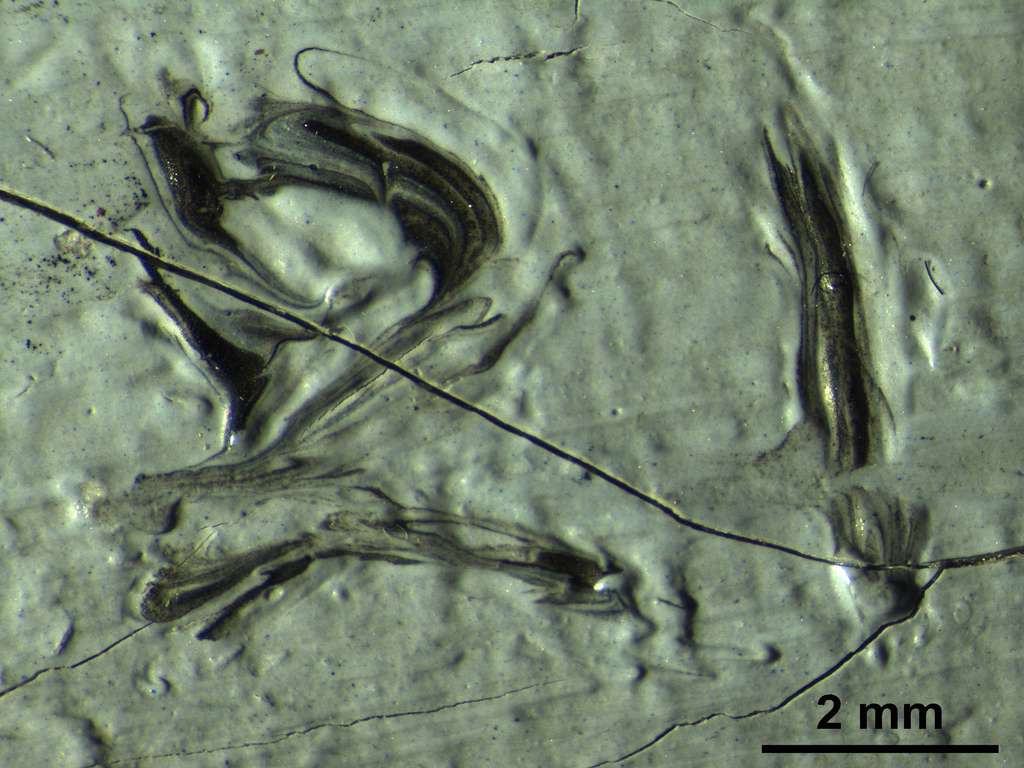
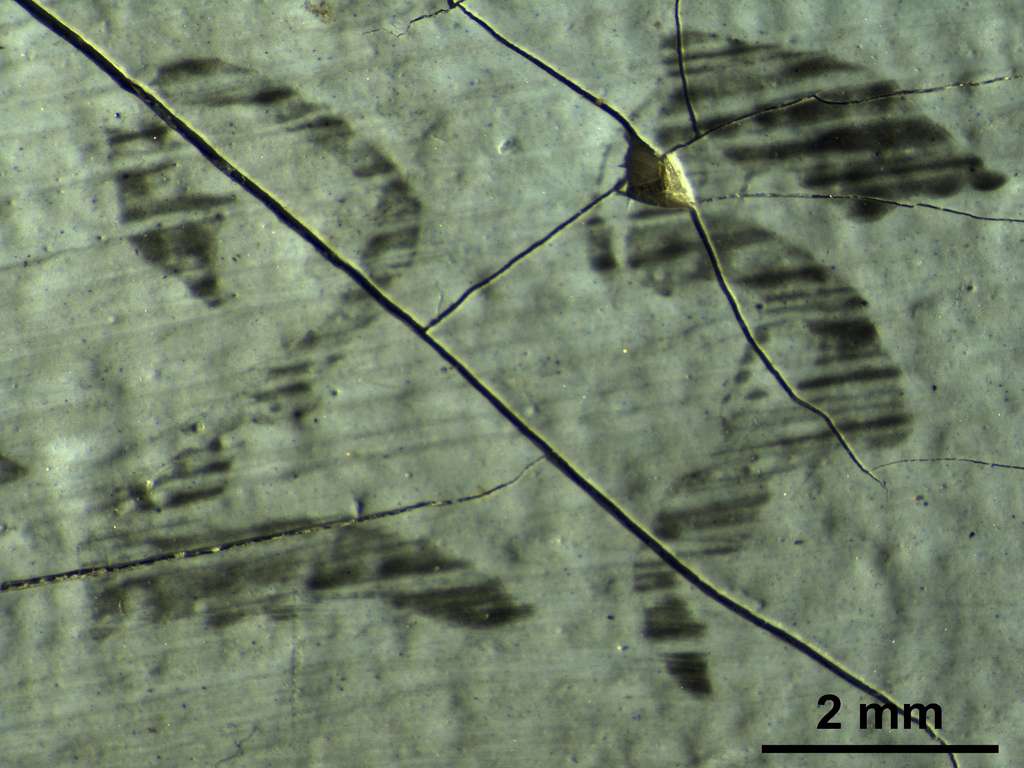
Detail of the number “21”, inscribed into the still fresh paint, and the number “25”, which was executed much later on top of the long-dry paint layer.
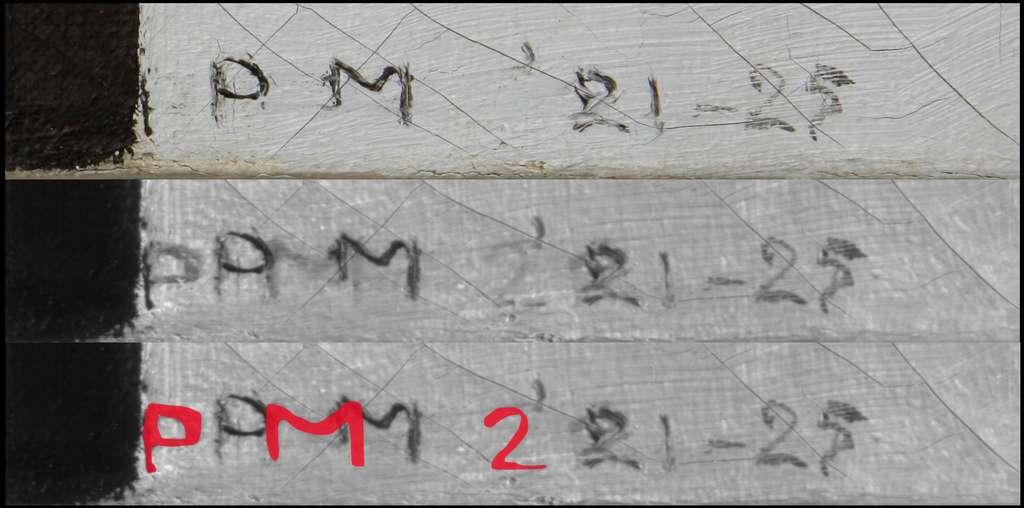
Detail of the present signature in normal light (above), in an infrared reflectogram revealing the first signature below the present-day surface (middle), and with this first signature highlighted in red (bottom).
Changes with stylistic development
Mondrian thus worked on Tableau I three times. The question arises: what did he change on each occasion? What did the first two versions look like? How did the composition evolve during these three separate creative phases? Since Mondrian frequently made changes to his paintings, often scraping or wiping off earlier versions entirely, it is difficult to identify concrete first versions. There are nevertheless many individual signs of revisions in Tableau I.
Grid and composition
The X-ray of Tableau I, for example, indicates that Mondrian had visualized a greater number of black lines in an earlier composition. These lines appear dark or light in the X-ray, depending on whether Mondrian scraped them away or overpainted them at a later stage. Superimposing these lines on the present composition makes it clear that the work started out with a denser grid.
Further evidence that Mondrian started with a strictly regular grid emerges when the work is examined with transmitted-light infrared reflectography. This reveals a clear grid, drawn with a pencil and ruler, beneath the paint layer of the red rectangles (unfortunately not visible in the case of the other colors).
Of course, this underdrawing might have belonged to another painting that Mondrian started, but then abandoned, and whose canvas he then re-used for Tableau I. However, if we extend this existing regular grid across the remaining color fields, and overlay it upon the present composition, it is astonishing to note that almost all lines and fields lie within the proportions of this grid, and that it thus underlies the entire composition like an imperceptible structure.
Mondrian worked with such regular grids as the starting point of his compositions from 1917 to 1920. The grid discovered beneath Tableau I might be an indication that Mondrian perhaps indeed began this painting in 1920.
Back and forth in size
By looking at the painting under the microscope, and by comparing its current appearance with the X-ray, we can see where Mondrian has made a number of changes to the black lines and to the colored rectangles. These changes are illustrated in the comparative images below. The detail taken from the X-ray shows that the black line was originally narrower and later widened. This is confirmed, too, under microscopic magnification: the black of the line overlaps the blue field. In raking light (a strong light shining from one side, revealing the painting’s surface structures), we can see that the blue field was originally larger and continues beneath the widened black line. The blue paint underneath can also be glimpsed in the open hairline cracks.
These detailed examinations were carried out on each line. They showed that all the black lines in Tableau I were widened, and that the height and width of the colored rectangles were slightly reduced as a result.
Mondrian employed narrower and in part gray lines only up to around the end of 1920, after which his grid lines become wider and exclusively black. Indications of gray paint can in fact be found under some of the black lines, which would in turn support the argument for a first version executed in 1920.
Colors on top of colors
Close examination of the outer edges of the painting, and of the borders of the colored rectangles, uncovered further interesting clues to the alterations made by Mondrian to Tableau I. At least two earlier layers of paint lie beneath almost every rectangle, some of them a very different color to the present composition.
The altogether five blue fields in the present painting, for example, were first a light blue, then dark blue, before Mondrian gave them the shade we see now. This process can be followed very clearly at the border of one of these fields in the detail image to the right.
The long, light blue rectangle running down the right-hand edge of the painting was actually red to begin with, as revealed by a small area of paint loss and underneath the open cracks. The fields today characterized by a paler shade of yellow were originally light gray, and then dark yellow. The red rectangles were originally an orange red before being painted in their present pure red.
The changing colors of Tableau I correspond to the evolution taking place in Piet Mondrian’s palette, as the artist moved away from the mixed tones found in his work up till around 1920/21, and towards increasingly pure primary colors.
Although the research carried out as part of the Piet Mondrian Conservation Project has yielded a wealth of new insights, it has only been possible to reconstruct the first two versions of Tableau I in an approximate fashion. Our findings nevertheless point to a first version dating from 1920 instead of 1921. The working and reworking processes that can be observed in Tableau I reflect the stylistic development that took place in Mondrian’s painting between 1920 and 1925, and which ultimately led him to his now famous Neoplasticism.
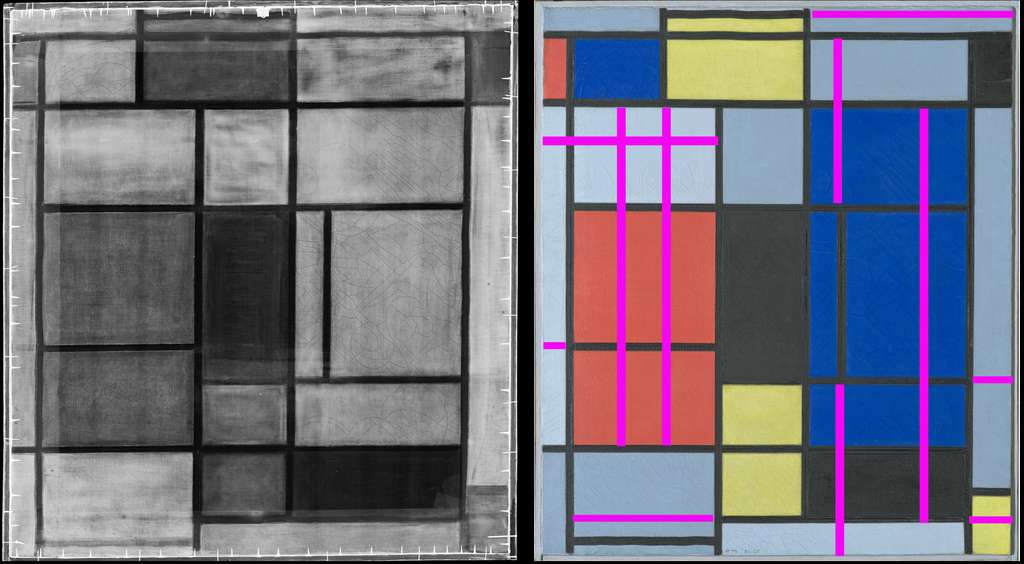
The X-ray (left) provides information on earlier compositional elements. On the right, these are overlaid upon the present composition in pink.
Explore more works
Eukalyptus
Eucalyptus provides a striking demonstration of Mondrian’s experiments with stylistic elements of Cubism in the treatment of composition and color.
Return to overview
Get an overview of the Piet Mondrian Conservation Project and the seven works being examined.
Composition No. VI
(Compositie 9, Blue Façade)
In Composition No. VI Piet Mondrian is more interested in the structural characteristics and colors of the house as sources of inspiration than in its figurative representation.
